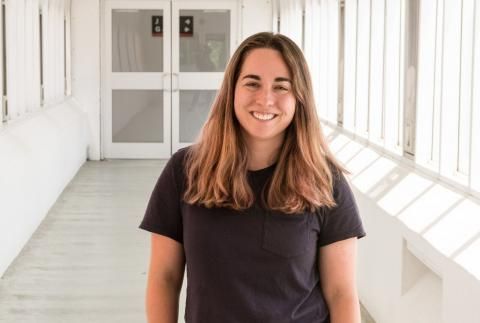Kerry Klemmer, a gifted artist who completed a triple major in astronomy, physics and studio art before attending Princeton as a doctoral student, thought about what field would best encompass her diverse interests and talents while leading to a practical career path. She came up with computational fluid dynamics (CFD).
The general field of fluid dynamics focuses on the flow of liquids and gases and their interactions with the forces around them. The computational part of CFD involves using computer calculations to discover and analyze the innumerable perplexing problems of fluid dynamics that many researchers work to resolve through simulations.
“I thought, engineering is practical and somewhat related to the research I’ve done in the past. Also, computation became a primary interest of mine,” says Kerry, who grew up in Ossining, just outside of New York City. “As I began looking into engineering subfields such as aeronautics and mechanical engineering — fields that I thought might be highly computational — one of the first things that came up was computational fluid dynamics.”

Analogous to her giant abstract paintings, CFD spans any number of perspectives and applications, from studying weather patterns, the evolution of stars and how blood circulates throughout the body to developing better combustion methods for advancing gas turbine and spacecraft engine technology.
So, after graduating with her bachelor’s degree from Wesleyan University, a private liberal arts college in Middletown, Ct., Kerry completed a one-year master’s program in CFD at Imperial College London.
Her new academic career trajectory landed her in the Department of Mechanical and Aerospace Engineering (MAE) at Princeton, where she is part of a CFD research group led by MAE Associate Professor Michael Mueller that investigates turbulent combustion through simulation and modeling.
The most detailed and accurate CFD simulations require huge amounts of processing power, often making these computer simulations “expensive.” This means that they hog up too much computer power, and the time to run them from beginning to end is too long to make their everyday use practical.
To address this problem, models that simplify the physics are used so that the simulations are less power hungry and run more efficiently. The tradeoff, however, is that more approximations are introduced into the predictive model.
This is where Kerry’s work comes in. Her research is an in area called uncertainty quantification, which involves estimating errors associated with these approximations in computational predictions.
In simplifying the physics, model errors are introduced, and with uncertainty quantification, we are trying to understand what these errors are in the most efficient way possible,” Kerry says.
In essence, Kerry’s job is to look for these errors so that the rest of her research group can account for them.
“I cannot stress enough how important this research is,” says Professor Mueller. “Realistically, we will never be able to develop perfect models to make perfect predictions. But if we can at least understand and quantify how accurate our simulations are, that would be immensely helpful.”
Kerry, who is going into her third year of studies at Princeton, chose the university for exactly the type of research that Professor Mueller’s group is conducting.
“I wanted the opportunity to be involved in uncertainty quantification, and I find turbulent combustion to be an interesting, multilayered problem,” she says. “Just firing up an engine involves multiple layers of physics.”
Types of specific problems her research team works on include simulation of soot formation in combustion models, understanding how conventional and alternative fuels affect engine performance, and flame stabilization in diesel and gas turbine engines.
To get up to speed on the nature of the work her team is involved in, Kerry took a graduate combustion course taught by Chung K. Law, the Robert H. Goddard Professor of Mechanical and Aerospace Engineering. She also participates in Princeton’s annual Combustion Summer School.
In addition to her research, Kerry remains very much interested in art, and the artwork she has created thus far has entailed a multilevel approach in its own unique way.
The first step involves constructing an abstract still life using household materials, such as colored tissue paper, honey (as the glue and for surreal liquid and bubble effects), plastic wrap and foil — items that tend to be colorful and shiny.
The 3-D material design is then photographed using various lighting techniques for distortion effects. Through paint, Kerry further obscures the identity of the materials to create abstract landscapes, where the paint as much as the image becomes the subject in the artwork.
“The idea is that when you look from a noticeable distance, the painting appears to be concrete with a 3-D dimensionality to it,” Kerry says.
Just as in her research endeavors at Princeton, Kerry’s artwork reflects her passionate, independent nature. There’s not really any one type of artwork she emulates in her own art pieces, except perhaps a hint of abstract impressionism and gesturalism.
“Some paintings by these artists are realistic images from a distance, but up close they become abstract,” says Kerry. “But you can’t see any tangible brush strokes, which is interesting in its own way, but in my own art, I needed to see those paint strokes. I needed the texture to be a part of the painting.”
“It has been a pleasure to work with Kerry over the last couple of years. She is an independent thinker and prefers to figure things out on her own,” Prof. Mueller says. “And, having an art, astronomy and physics background definitely offers our group a unique perspective.”
-Jodi Ackerman Frank